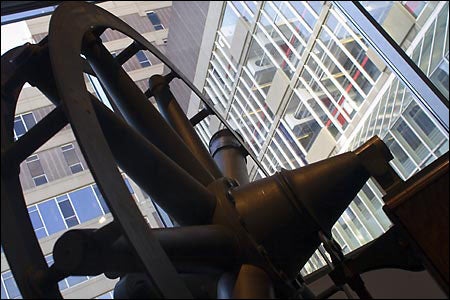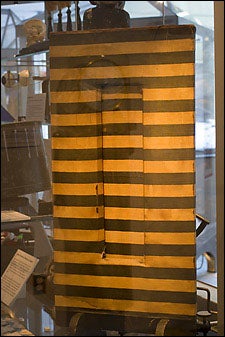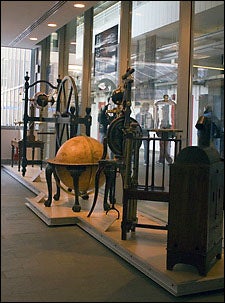Galileo to cyclotron: History on display
New science gallery showcases historical instrument collection

In the 1800s, the railroads crisscrossing New England had a problem.
With single lines for trains running in both directions, timing train departures and arrivals precisely was essential to avoid crashes. But with local time kept by sundials in towns across the region – which would vary as one traveled west – timekeeping was inconsistent.

The result was disaster. Between 1831 and 1857 there were 97 train wrecks in New England, most of which were blamed on bad timekeeping.
The solution came when the Harvard College Observatory began to sell time to the railroads. Harvard clocks were connected through wires to clocks in South Station in Boston and to other stations along the line. The system not only helped cut the number of train crashes, it led to the first time zone.
“New England Standard Time was kept by these clocks,” said Sara Schechner, Wheatland Curator of the Collection of Historical Scientific Instruments.
This account of the Harvard clocks is just one of several stories of science at Harvard told visually in a new Science Center gallery where Harvard’s Collection of Historical Scientific Instruments is presented.
Previously housed in a gallery in the Science Center’s basement, the new glass-fronted Putnam Gallery puts the collection prominently on display on the Science Center’s first floor next to the building’s east entrance.
“The Putnam Gallery offers an exceptional view of the critical role that instruments have played in the history of scientific learning and knowledge,” said Allan M. Brandt, Kass Professor of the History of Medicine, professor of the history of science, and chairman of the History of Science Department. “The gallery will greatly enhance our teaching and research into the technologies that have assisted in our understanding of the natural world.”
Schechner said the gallery, which had its official opening Nov. 30, presents some of the treasures of the Harvard collection, such as a “geometrical and military compass” designed by Galileo, one of only three in existence, and the collection’s oldest item, an astrolabe dating to 1400. But beyond these items, it uses Harvard’s collection, gathered since Harvard began acquiring scientific instruments in 1672, to tell selected stories of science from the Renaissance to the modern era.
“These are some of our star objects, ones we know people will want to see,” Schechner said. “But we do more than show off our treasures in here. We use the instruments to explore different themes and issues in the history of science.”
Schechner said it would be impossible to present a continuum of the entire history of science, so she designed the exhibit around what she called “hinge moments,” when understanding in particular areas took leaps forward or intersected with ideas from other disciplines, politics, or religious beliefs. Though not exclusive in its focus on science at Harvard, the gallery emphasizes work done here.
The exhibit presents a variety of instruments from the colonial era, including a “magic lantern,” which is essentially an early slide projector, where images on glass were projected using light produced by burning whale oil. There are also several instruments used for creating static electricity including one dubbed the “flying bedstead” because the carpenters engaged in building the machine apparently drew on their previous experience in making beds.
The exhibit takes a visitor through the 1700s, 1800s, and 1900s with advances in astronomy told through vintage telescopes, the beginnings of astrophysics with early spectrographs, and the growth of psychology and the physiology of the sensory organs told in cases displaying experiments on perception. Harvard’s first government grant, received in World War II, was focused on controlling sound in combat situations because of the effects that loud noises had on fighter pilots and tank crews. At least one piece of equipment in this case reflects the top secret nature of the acoustics research with the label “Anonymous Research.”

The exhibit ends with a large control console from Harvard’s cyclotron, whose proton beam was first used for physics research and then for medical treatments. The cyclotron was dismantled just a few years ago and preserved as it was the final day it was in use. Schechner pointed out the older equipment dating to the 1940s side by side with newer computer monitors, complete with notes written by the operators. Schechner, who worked to preserve a representative portion of the cyclotron as it was dismantled, preserved a bulletin board where instructions to clean up toxic mercury spills are thumb-tacked next to a take-out menu for a Chinese restaurant.
The juxtaposition, Schechner said, reminds us that despite its emphasis on dispassionate facts, science is ultimately an activity of people, an activity influenced by our strengths, failings, and the societies within which the work is done.
“These things are preserved the way they were when scientists used them,” Schechner said. “These are human things.”




